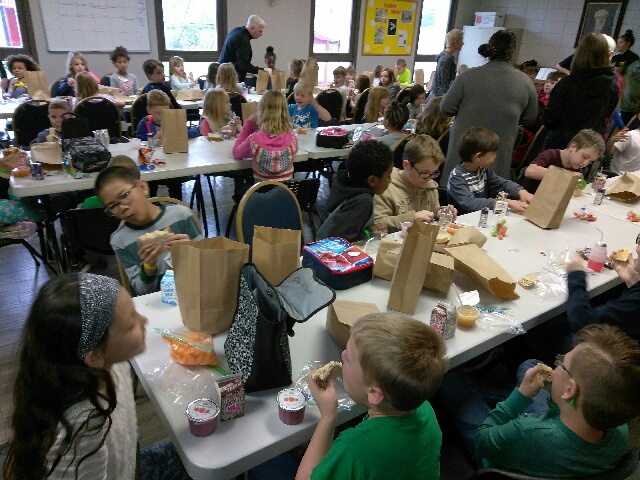
Salvation Army Tulsa
States vary widely in giving children access to summer meals through the federal Summer Nutrition Program. In Oklahoma, fewer than 5 percent of eligible children got summer lunches in 2017, compared with nearly 50 percent in the District of Columbia, according to the Food Research & Action Center.
What if funds were available to support marginalized kids in your state but nobody bothered to use the money?
That’s the case with federal money for summer meals for kids.
States are leaving money on the table, said the Food Research & Action Center in a June report on the federal Summer Nutrition Program.
“In some states there just aren’t enough summer programs [to offer meals],” said Clarissa Hayes, child nutrition policy analyst at the Center (FRAC), a national nonprofit that addresses poverty-related hunger and undernutrition.
The No. 1 reason for not using the funds is that there aren’t enough sponsoring organizations to administer the funding and not enough summer programs that can serve as meal sites, she said.
“There’s also a general lack of awareness of these programs,” Hayes said.
But the need is there.
And in high-poverty states like Oklahoma, some change may be occurring.
Households under pressure

Chris Bernard
About 12 percent of U.S. families face enough financial pressure or other challenges that they are described as food insecure.
When families don’t have adequate money for groceries, they report such coping strategies as not paying utility bills (nearly two-thirds of those surveyed), cutting back on medical expenses (nearly half) or not paying the rent (40 percent), according to the Department of Agriculture.
Oklahoma has one of the highest proportions of children who live in food-insecure households, 22.7 percent, according to Feeding America, a nonprofit with a network of food banks and pantries across the country.
It’s also the state that feeds the fewest of its children who are eligible for summer meals, according to FRAC. Last summer, only 4.7 percent of Oklahoma children eligible for free or reduced-price school lunches received summer meals, according to the center’s report. The number of meal sites dropped by 70 from 2016.
And yet Oklahoma could receive $8.1 million extra if it raised that percentage to 40, according to the center.
New Mexico, with the highest rate of food-insecure children, feeds summer meals to 28 percent of the kids who are eligible during the school year. It could bring in an additional $1.5 million, according to FRAC. Mississippi could add $7.1 million.
Suspicious of the money
In Oklahoma many people question the wisdom of accepting federal dollars for assistance.

Clarissa Hayes
However, in 2016 the Tulsa-based Anne and Henry Zarrow Foundation commissioned a report to explore food insecurity in Oklahoma and systemic solutions to it.
The report identified millions of federal dollars that were available but not being used. It calculated that Oklahoma could bring in $400 million if it fully utilized the federal school breakfast, after-school and summer meals programs, as well as the food welfare programs SNAP (Supplemental Nutrition Assistance Program) and WIC (Women, Infants and Children).
But an administering organization was needed.
“Very early, it became clear … that one of the big holes was that there was no advocacy and backbone organization,” said Chris Bernard. He is now executive director of Hunger Free Oklahoma, the nonprofit created in 2016 with funding from the Zarrow Foundation to address food issues.
“Our goal is to boost our numbers,” he said. Hunger Free Oklahoma is bringing stakeholders together to expand public access to existing programs.
In Oklahoma there tends to be dislike for the words “federal programs,” Bernard said. Perhaps as a result, the state pays out more federal taxes than it gets back.
Instead of seeking federal funding, some community organizations prefer to raise money through charitable donations and feed kids that way, he said.
But why not use the available federal dollars — as well as the charitable donations — to do a better job of providing what kids need, Bernard asks.
Strategies for change
“The paperwork [in federal programs] is difficult,” he acknowledged. Local community organizations don’t like to navigate it, he said.
Hunger Free Oklahoma plans to work with them to standardize and improve their ability to handle the paperwork, Bernard said.
Another difficulty for summer meal programs is locating sites in areas where the population is spread out.
“That is a big challenge in rural Oklahoma,” he said. Hunger Free Oklahoma is identifying priority areas to set up sites.
The best practice for summer meals is to have programs tied to them, Bernard said. A meals-only site can feel stigmatizing, he said.
When meal sites partner with organizations that address children’s other needs, such as for academic enrichment, they can create a broad safety net.
“We’re very interested in partnering with existing summer learning programs,” he said.
Hayes, of FRAC, said that more summer meal sites are becoming part of programs taking a wholistic approach — addressing youth development as a whole. They’re addressing the “summer slide,” child obesity and other issues.
“The places we’re seeing a lot of success is where they are working to wrap all these priority areas into the summer meal program,” she said.
And in a sign that things may be changing in Oklahoma, the state department of education has included the summer meals program into the state’s ESSA (Every Student Succeeds Act) plan as an evidence-based intervention for struggling students, Bernard said.
“The current superintendent has made child nutrition programs a priority,” he said.
Oklahoma’s department of education now has a new goal: to raise the number of meals served in the summer by 30 percent by 2025, he said.





























